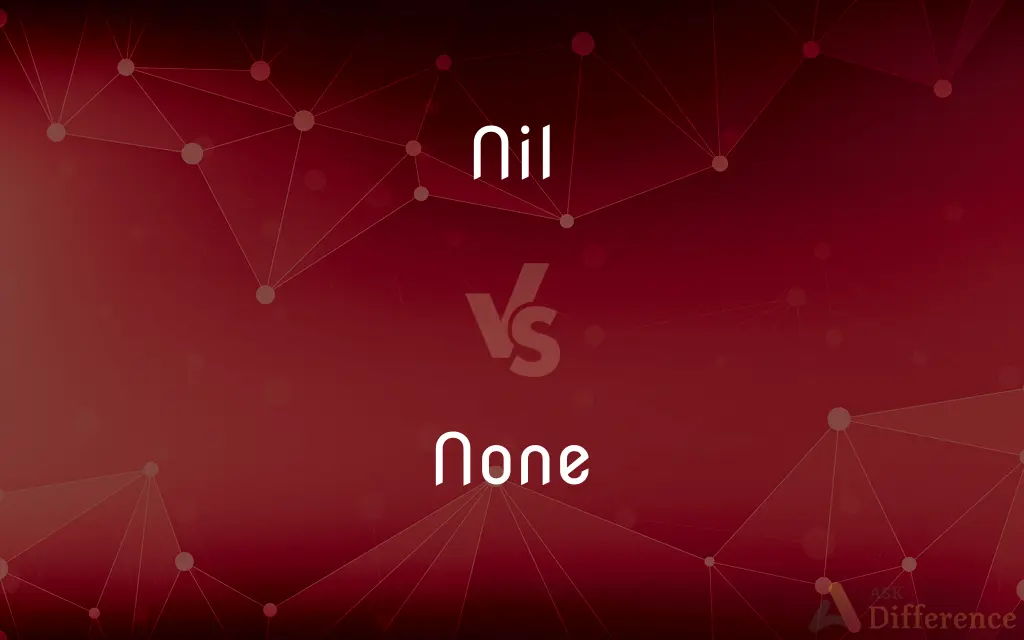Nil vs. None — What's the Difference?
By Tayyaba Rehman & Urooj Arif — Updated on February 26, 2024
Nil and None both signify the absence of value, but Nil is often used in sports and mathematics to indicate zero, while None is used in programming languages like Python to represent the absence of a value or a null reference.

Difference Between Nil and None
Table of Contents
ADVERTISEMENT
Key Differences
Nil is a term frequently encountered in contexts like sports scores and mathematics, where it signifies zero or no amount. None, on the other hand, finds its primary usage in programming, particularly in Python, where it denotes the absence of a value or a null reference.
A soccer match result may be described as "2-nil," indicating one team scored two goals while the other scored none in context of Nil. None used to represent a void or that a variable has not been assigned any object.
Nil has its origins in Latin (from "nihil," meaning "nothing"), making it a common choice in various European languages for indicating nothingness or zero, None is derived from Old English "nān," meaning "not one" or "not any," which reflects its use in English to indicate an absence of quantity or value.
When keeping score in games, "nil" is preferred for its brevity and clarity. For instance, describing a game's outcome as "3-nil" conveys quickly that one side scored three times while the other did not score at all. None is particularly significant because it helps in error checking and managing the absence of values in a way that prevents programs from crashing in computer science. It allows developers to distinguish between a deliberate "no value" and an empty value like an empty list or string.
Comparison Chart
Primary Usage
Sports, Mathematics
Programming
ADVERTISEMENT
Meaning
Zero or no amount
Absence of a value or object
Origin
Latin ("nihil")
Old English ("nān")
Example Context
"The team won 4-nil."
"The variable is set to None."
Significance
Indicates a score or lack of quantity
Represents a null reference or an intentional absence of value
Compare with Definitions
Nil
A score of zero in sports.
The final score was 3-nil.
None
In a legal or formal context, meaning not any.
None of these regulations apply to us.
Nil
Used to describe a lack of quantity or value.
The chances of success are practically nil.
None
A placeholder for a lack of value in programming.
If the search finds no match, the function returns None.
Nil
In certain card games, a bid of zero tricks.
She made a daring nil bid.
None
Used to signify no part or share of something.
None of the participants disagreed.
Nil
Representing zero in mathematical equations.
The sum of the equation equals nil.
None
Indicating the absence of all members of a group.
None of the cookies were left.
Nil
A term used in formal records to indicate none or nothing.
The survey found nil evidence of wrongdoing.
None
Used to express no amount or degree.
The situation has improved none since last week.
Nil
Nothing; zero.
Nil
(sports) A score of zero
The football match ended in a nil-nil draw.
Common Curiosities
How is None used in programming?
None is used in programming languages like Python to represent the absence of a value or a null reference.
What does None mean in Python?
In Python, None represents a null value or a value that does not exist.
Is Nil used in computer programming?
Nil is less commonly used in modern programming languages, with None or similar keywords taking its place.
Can Nil and None be used interchangeably?
While both indicate an absence of value, their usage is context-dependent, making them not directly interchangeable.
How do you use Nil in a sentence?
"The home team defeated the visitors five-nil."
Where does the term Nil originate from?
Nil originates from the Latin word "nihil," meaning "nothing."
How is None used outside of programming?
None is used to denote the absence of any quantity or value in general English usage.
How does the usage of Nil and None differ in formal writing?
Nil is used for specific contexts like sports or mathematics, while None is used more broadly to indicate absence.
Can None represent a zero value?
While None implies a lack of value, it doesn't necessarily equate to the numerical value of zero.
What is Nil used for?
Nil is primarily used to indicate zero or no amount, especially in sports scores and mathematics.
Can Nil be used in Python?
In Python, the term for a null value is None, not Nil.
What is the difference in origin between Nil and None?
Nil has Latin origins, whereas None comes from Old English.
Is there a scenario where Nil is preferred over None?
In describing sports scores and mathematical contexts, Nil is preferred for its specificity to zero.
Is None specific to Python?
While None is notably used in Python, the concept of a null or none value exists in various programming languages.
What does it mean when a variable is set to None in programming?
It means the variable has been declared but not assigned any specific value or object, indicating a deliberate absence of value.
Share Your Discovery

Previous Comparison
Waste vs. Wastage
Next Comparison
Plot vs. LotAuthor Spotlight
Written by
Tayyaba RehmanTayyaba Rehman is a distinguished writer, currently serving as a primary contributor to askdifference.com. As a researcher in semantics and etymology, Tayyaba's passion for the complexity of languages and their distinctions has found a perfect home on the platform. Tayyaba delves into the intricacies of language, distinguishing between commonly confused words and phrases, thereby providing clarity for readers worldwide.
Co-written by
Urooj ArifUrooj is a skilled content writer at Ask Difference, known for her exceptional ability to simplify complex topics into engaging and informative content. With a passion for research and a flair for clear, concise writing, she consistently delivers articles that resonate with our diverse audience.














































